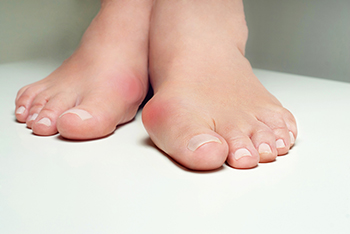Call Us Today! (203) 975-9600
SAME DAY APPOINTMENTS AVAILABLE
What Can Cause Bunions?
Tuesday, 01 August 2023 00:00
A bunion can form on the side of the big toe as a result of wearing shoes that do not have ample room for the toes to move freely in. High heels can fall into this category, and it is beneficial to choose shoes that have a square toe area. Bunions can be painful and may cause the other toes to shift toward each other. The symptoms can include redness surrounding the bunion, and corns or calluses may form on top of it as it touches the shoe. Some people may experience numbness or sharp pains, which can come from existing nerve damage. Research has indicated that bunions are rare in people whose cultures deem it normal to routinely walk barefoot for the majority of the day, as the feet are not confined in tight shoes. Many people find mild relief when a protective pad is placed over the bunion, and larger shoes are worn. If you have developed a bunion, it is strongly suggested that you visit a podiatrist who can offer treatment options that are correct for you, which may include surgery for permanent removal.
If you are suffering from bunion pain, contact one of our podiatrists of Preferred Footcare, LLC. Our doctors can provide the care you need to keep you pain-free and on your feet.
What Is a Bunion?
Bunions are painful bony bumps that usually develop on the inside of the foot at the joint of the big toe. As the deformity increases over time, it may become painful to walk and wear shoes. Women are more likely to exacerbate existing bunions since they often wear tight, narrow shoes that shift their toes together. Bunion pain can be relieved by wearing wider shoes with enough room for the toes.
Causes
- Genetics – some people inherit feet that are more prone to bunion development
- Inflammatory Conditions - rheumatoid arthritis and polio may cause bunion development
Symptoms
- Redness and inflammation
- Pain and tenderness
- Callus or corns on the bump
- Restricted motion in the big toe
In order to diagnose your bunion, your podiatrist may ask about your medical history, symptoms, and general health. Your doctor might also order an x-ray to take a closer look at your feet. Nonsurgical treatment options include orthotics, padding, icing, changes in footwear, and medication. If nonsurgical treatments don’t alleviate your bunion pain, surgery may be necessary.
If you have any questions, please feel free to contact our office located in Stamford, CT . We offer the newest diagnostic and treatment technologies for all your foot care needs.
Call Us Today! (203) 975-9600
SAME DAY APPOINTMENTS AVAILABLE








